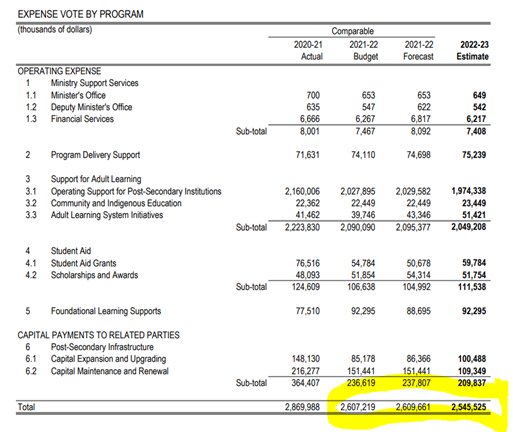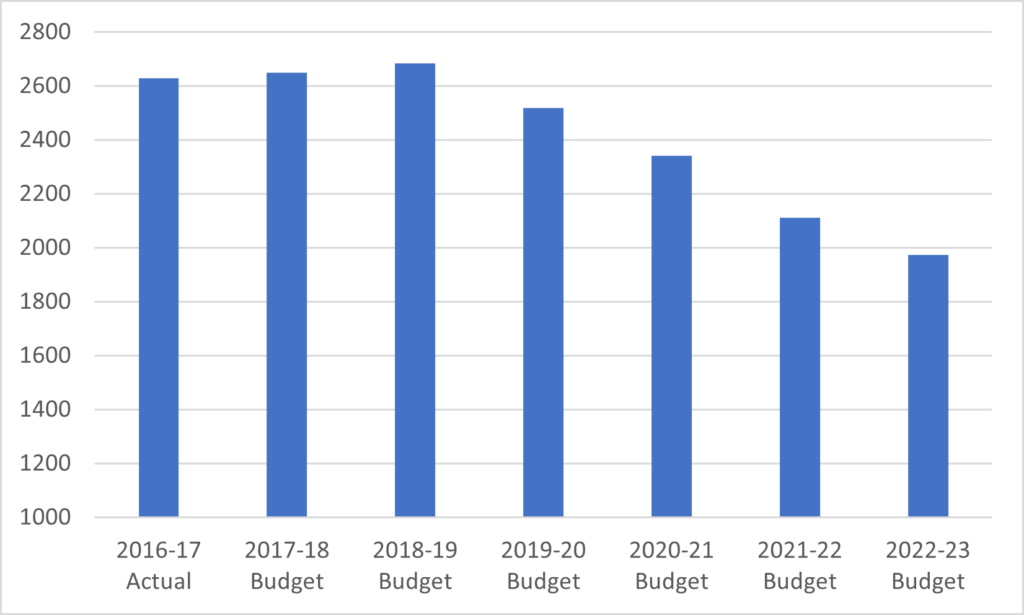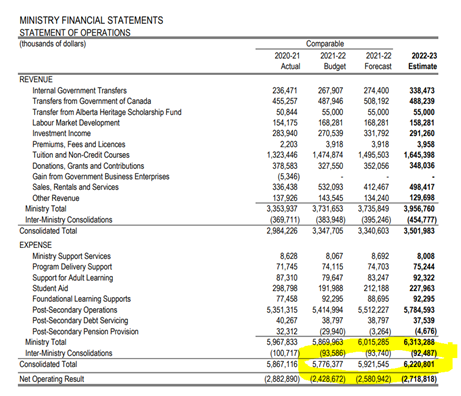The Alberta Budget came out last week. As usual, the way Alberta presents its numbers creates enormous confusion and scope for spin, so permit me to run through the numbers with you.
Recall from last year’s explainer that in its annual budget, the government runs two sets of numbers on post-secondary education. The first is a straightforward “Expense Vote by Program”: that is to say, what the government is actually spending. The image below shows how that looked in the budget presented last week. The key bit is to stuff at the bottom in yellow: it’s a budget-to-budget drop of $62 million, the vast majority of which is the result of cuts to institutional budgets (see line 3.1).

No real surprise here: we knew last year that there would be at least one more year of cuts. As Figure 1 shows, transfers to institutions are now down 26% in real terms since Budget 2018-19.
Figure 1: Alberta Government Support to Post-Secondary Institutions, 2016-17 to 2022-23 in millions of constant $2022.

Now, the Ministry also publishes a “statement of operations,” which looks entirely different. This is because years ago the Auditor General decided that all institutions in Alberta were effectively “too-big-fail” (Laurentian was not even a gleam in Ernst & Young’s eye at this point), and because of this, it was determined that all institutions’ books had to be carried on the province. The McKinsey report from last year recommended strongly that this was inappropriate and if I recall correctly, the government has accepted that at least universities should be removed from their ledger. Anyways, below you can see what is going on in this statement: an increase in sector-wide income of about $444 million.

So how does a $62 million funding-cut square with a $444M funding increase? Here’s where it gets complicated. In part, this increase in funding comes from tuition fee income, which is projected to rise by just under 12% – that is, an increase in private income. But the rest of it comes from this mysterious “net operating result” – which is basically the remainder after all the private and third-party money is counted. in the past, this “remainder” figure used to be reasonably close to the actual government operating transfer to institutions; in fact, in 2020-21, the two numbers were almost identical. And this would make sense on the basis that all that private, third-party income plus government subsidy should equal total institutional income.
But something strange has been happening over the past two budgets, namely that the “net operating result” has ceased to be a proxy for actual government spending. As Figure 2 shows, as of 2022, there is now a nearly $750 million gap between the two.
Figure 2: Transfers to Post-Secondary Institutions Plus Projected “Net Operating Results” from AB Advanced Education Business Plans Plus. 2019-20 to 2022-23

What does this gap consist of? Well, the Government seems to want everyone to think that it’s at least partially to a new 3-year, $171 million “expansion fund” – that is, targeted money to expand seats in higher education (for those of us in Ontario, the government specifying new enrolment targets in exchange for money seems deeply weird, but it’s pretty much the way things work in Manitoba, Alberta and British Columbia). But remember, actual spending on post-secondary education funding actually went down this year. So, if this is “new” money, it’s new in the sense that until quite recently, they were expecting a bigger cut in this fiscal year, i.e. not new net money, but possibly new money on top of an previously-projected (though never explicitly stated) baseline. Remember when the Liberals and NDP wrongly claimed the Harper government was “cutting” health budgets because he lowered the rate of growth from 6% p.a to 3%? This is exactly like that, but in reverse.
What else could be in that $750 million? Lord knows. I expect it is mostly expected increases in international tuition fees, since the business plan is projecting almost no real growth in fees through to 2025 despite that clearly being the route most institutions are taking to offset the fall in government revenue. It would be great if the Government of Alberta could give us an answer on this by providing coherent explainers that reconcile their legislative votes with their reporting structure for operating results. But they’ve been like this since the early 90s and I’m not expecting a change anytime soon. Guess I’ll have to keep writing these explainers.

 Tweet this post
Tweet this post

The government also increased interest rates on student loans: student fees up and interest on student loans up.